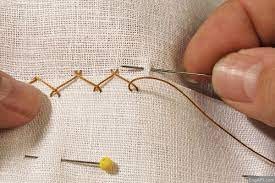

sew
音标:
美音:/soʊ/,英音:/səʊ/
听听基本释意:
外刊例句:
One teenager ran green and yellow fabric through a sewing machine as he sat beneath a beach umbrella bearing a picture of Angola’s president, João Lourenço.
一名少年坐在一把印有安哥拉总统若昂·洛伦索 (João Lourenço) 照片的沙滩伞下,用缝纫机缝制绿色和黄色的布料。
—New York Times
His first job was in a sewing machine factory.
他的第一份工作是在一家缝纫机厂。
—BBC
A week later, he won 10 of the 14 Super Tuesday primaries to essentially sew up the nomination.
一周后,他赢得了 14 场超级星期二初选中的 10 场,基本上锁定了提名。
—Washington Post
基本释意:
verb
create (clothes) with cloth
v. 缝,缝纫,缝补
同义词:
tailor,tailor-make,run up,sew together,stitch
短释义:
Sew describes stitching something together. If you sew up the holes in your socks, you use thread and a needle to close them.
Sew 描述了将某物缝合在一起。如果你缝合袜子上的洞,你可以用线和针来缝合它们。
长释义:
The word sew comes from the Old English word siwian, to stitch. You can sew a patch on a pair of jeans, sew a dress, or sew up a hole in your grandmother’s old quilt. A figurative meaning of sew, as in the phrase to sew something up, is to secure something or bring it to a happy conclusion, like sewing up the plot in the last chapter of a book. Don’t confuse sew with sow, to plant or set in motion.
sew 这个词来自古英语单词 siwian,缝合。你可以在一条牛仔裤上缝一个补丁,缝一条裙子,或者在你祖母的旧被子上缝一个洞。 sew 的比喻意义,就像在短语 to sew something up 中一样,是为了确保某物或将其带入一个幸福的结局,就像在一本书的最后一章中缝合情节一样。不要将缝纫与播种、播种或启动相混淆。
文学例句:
Helping somebody else sew was twice as hard as making something herself.
帮助别人缝纫比自己做东西难两倍。
—Out of Darkness by Ashley Hope Pérez
And were face to face with a semi-transparent guy in medieval garb with a fur-trimmed cap and a beard that looked like two raccoon tails sewn together under his nose and chin.
面对面的是一个穿着中世纪服装的半透明人,戴着一顶毛边帽子,胡须看起来就像两条浣熊尾巴缝在他的鼻子和下巴下面。
—Escape from Mr. Lemoncello’s Library by Chris Grabenstein
Her face is long, her mouth slightly lopsided; something about the top lip is a little skewed, as if it’s been cut open and sewn up crooked.
她的脸很长,嘴巴有点歪;上唇有点歪斜,好像被切开缝合歪了一样。
—Cat’s Eye by Margaret Atwood
词源:
sew (v.)”unite or attach (fabric, etc.) by means of thread or similar material, with or without aid of a needle or awl;” Middle English seuen, from Old English siwian “to stitch, sew, mend, patch, knit together, fasten by sewing,” earlier siowian, from Proto-Germanic *siwjanan (source also of Old Norse syja, Swedish sy, Danish sye, Old Frisian sia, Old High German siuwan, Gothic siujan “to sew”), from PIE root *syu- “to bind, sew.”From c. 1200 as “produce or construct (clothing, a garment) by means of a needle and thread.” The intransitive sense of “work with a needle or thread, practice sewing” is by mid-15c. Related: Sewed; sewing. Sewn is a modern variant past-participle.To sew up (a wound, etc.) “close by stitching the edges together” is by late 15c. (Caxton); the modern colloquial sew (something) up “bring to a desired conclusion” is a figurative use attested by 1904.Related entries & more
下面是词源的翻译(机器翻译比较难翻,参考着看)
缝合 (v.)“用线或类似材料连接或连接(织物等),有或没有针或锥子的帮助;”中古英语 seuen,源自古英语 siwian“缝合、缝纫、修补、修补、编织在一起,通过缝纫固定”,早期的 siowian,源自原始日耳曼语 *siwjanan(也源自古挪威语 syja、瑞典语 sy、丹麦语 sye、旧语弗里斯兰语 sia,古高地德语 siuwan,哥特语 siujan “缝合”),源自 PIE 词根 *syu- “绑定,缝合”。来自 c. 1200 作为“通过针和线生产或构造(衣服,服装)”。 “用针或线工作,练习缝纫”的不及物意义是在 15c 中期。相关:缝合;缝纫。 Sewn 是过去分词的现代变体。要“缝合(伤口等)”“通过将边缘缝合在一起”是在 15 世纪末。 (卡克斯顿);现代口语中的 sew (something) up “bring to a desired conclusion” 是一种比喻用法,1904 年得到证实。相关条目及更多
本站没有存储任何书籍、杂志和报纸。
页面内容只做展示和推荐。如果您喜欢本期内容请购买正版。
This site does not store any books, magazines or newspapers.
The contents of the pages are for display and recommendation only.
If you like the content of this issue please purchase the original.